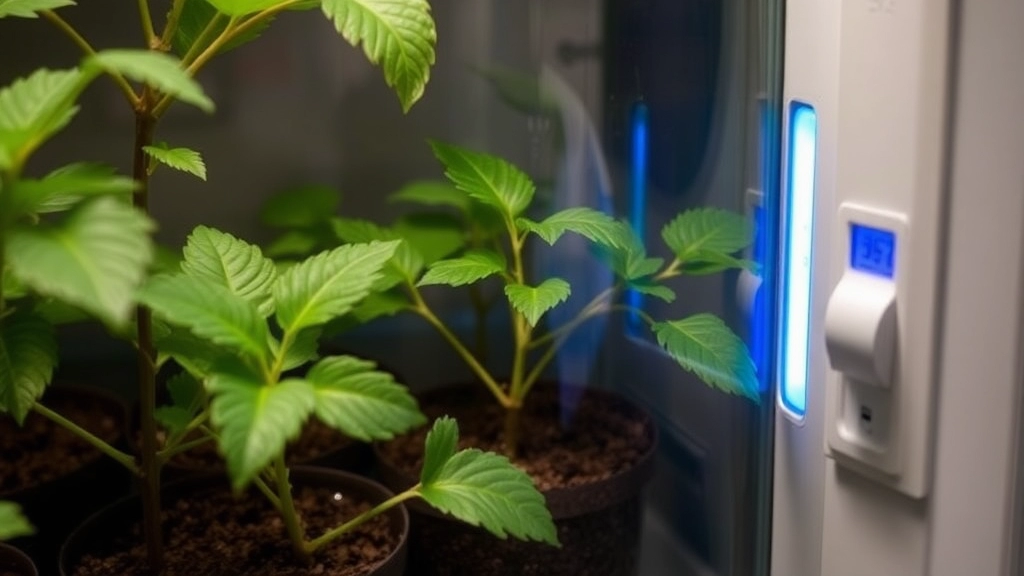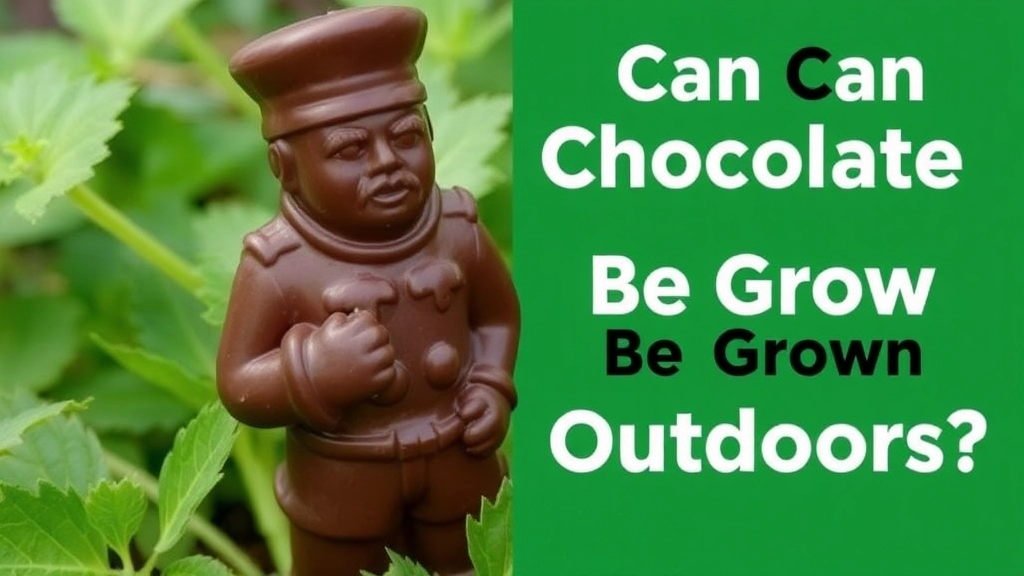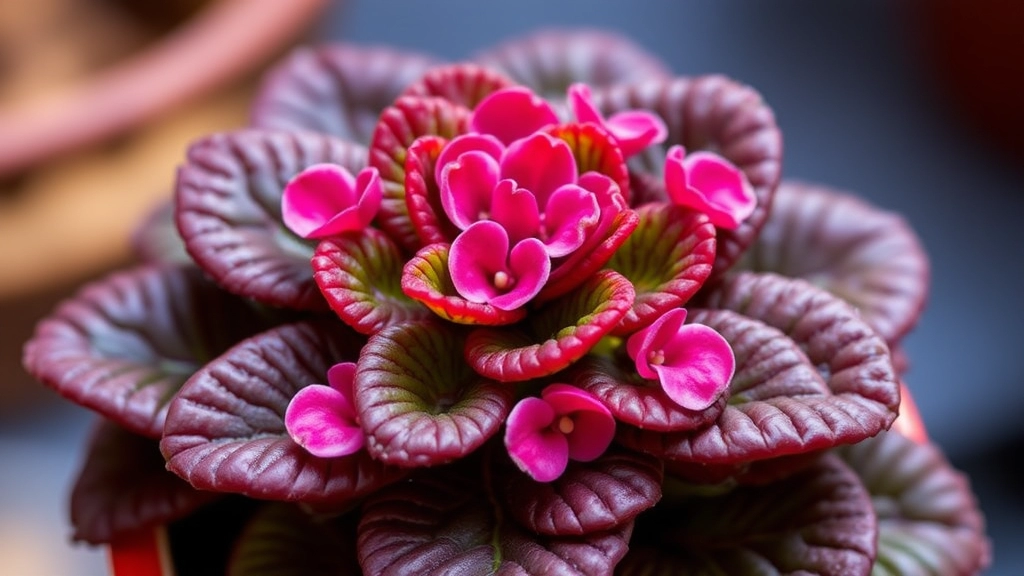Mastering Kalanchoe Chocolate Soldier Care
Looking to master Kalanchoe Chocolate Soldier care? You’re in the right place. This unique succulent, with its chocolate-hued leaves, is a favourite among plant enthusiasts. To keep it thriving, you’ll need to know about its light, watering, soil, and temperature needs. Let’s dive into the essentials to ensure your Chocolate Soldier stays healthy and vibrant.
Essential Care Tips
First off, light is crucial. Your Kalanchoe Chocolate Soldier will flourish in bright, indirect sunlight. Next, the soil should be well-draining to prevent root rot. Watering is key—allow the soil to dry out between waterings to avoid overwatering. Temperature and humidity also play a role; aim for a warm environment with moderate humidity. Follow these tips, and your Chocolate Soldier will thank you!
Light Requirements for Chocolate Soldier
When it comes to growing a Chocolate Soldier plant, one of the most pressing questions is about its light requirements.
Optimal Lighting Conditions
Chocolate Soldier plants thrive in bright, indirect light. Here’s what you need to know:
- Avoid Direct Sunlight: Direct sunlight can scorch the leaves, leading to unsightly brown patches.
- Bright, Indirect Light: Place your plant near a window with filtered light or use sheer curtains to diffuse the sunlight.
- Supplemental Lighting: If natural light is limited, consider using grow lights to provide the necessary brightness.
Signs of Adequate Light
You’ll know your Chocolate Soldier is getting the right amount of light if:
- The leaves are vibrant and lush.
- The plant maintains a compact shape rather than becoming leggy.
Inadequate light can lead to stress, so it’s essential to monitor your plant’s condition closely. For more detailed care instructions, check out our step-by-step guide on Kalanchoe Chocolate Soldier propagation. Additionally, if you’re interested in learning about other Kalanchoe varieties, our guide on top Kalanchoe varieties with pink edges is a must-read.
Best Soil Types for Healthy Growth

So, you’ve got your Chocolate Soldier plant and you’re wondering about the best soil for it to thrive, right?
Choosing the right soil is crucial for your plant’s health.
Soil Composition
- Well-Draining Mix: Chocolate Soldiers prefer a soil that drains well but retains some moisture. A mix of potting soil with perlite or coarse sand works wonders.
- pH Level: Aim for a slightly acidic to neutral pH, around 6.0 to 7.0. You can use a simple pH testing kit to check this.
- Organic Matter: Adding compost or well-rotted leaf mould can give your plant that extra boost it craves. It helps with nutrient retention and improves soil structure.
Container Considerations
If you’re planting in a pot, ensure it has drainage holes. This helps prevent water from pooling at the bottom, which can lead to root rot.
Common Soil Mistakes
- Heavy Soils: Avoid using heavy garden soil; it can compact and suffocate the roots.
- Over-Fertilization: Too much fertiliser can alter the soil’s composition negatively. Stick to a balanced approach.
Watering Schedule and Techniques for Chocolate Soldier
When it comes to nurturing your Chocolate Soldier plant, understanding its watering needs is essential. Overwatering and underwatering can lead to stress and health issues, which is a common concern for many plant enthusiasts.
Optimal Temperature and Humidity Conditions for Chocolate Soldier

When cultivating Chocolate Soldier plants, one of the most pressing concerns is ensuring the right temperature and humidity levels. Without these optimal conditions, your plant may struggle to thrive.
Ideal Temperature Range:
- Daytime: Aim for temperatures between 20°C to 25°C (68°F to 77°F).
- Nighttime: A drop to around 15°C to 18°C (59°F to 64°F) is beneficial.
Maintaining this range helps the plant grow vigorously and produce lush foliage.
Humidity Levels:
- Chocolate Soldier plants prefer humidity levels around 50% to 70%.
- If the air is too dry, consider using a humidifier or placing a tray of water near the plant to increase moisture.
Why Temperature and Humidity Matter:
- High temperatures can lead to wilting or leaf drop.
- Low humidity can cause leaf browning and hinder growth.
Practical Tips:
- Monitor your plant’s environment with a thermometer and hygrometer.
- Avoid placing your plant near heating vents or drafty windows.
Fertilization Tips for Chocolate Soldier Plants
When nurturing your Chocolate Soldier plant, fertilization plays a pivotal role in promoting robust growth and vibrant foliage. Many plant enthusiasts often wonder how to provide the best nutrients for their beloved greenery.
Understanding Nutrient Needs
Chocolate Soldiers thrive on a balanced diet of nutrients. Here’s what you should consider:
- Type of Fertiliser: Use a balanced, water-soluble fertiliser, such as a 10-10-10 or a 20-20-20 formula. This ensures your plant receives equal parts nitrogen, phosphorus, and potassium.
- Frequency: Fertilise every 4-6 weeks during the growing season (spring and summer). Reduce or halt fertilisation during the dormant months (autumn and winter).
- Dilution: Always dilute the fertiliser to half the recommended strength. This prevents root burn and encourages healthy growth.
Organic Options
For those inclined toward organic gardening, consider these alternatives:
- Compost Tea: Rich in nutrients, it can be applied every month to boost soil health.
- Fish Emulsion: This is an excellent source of nitrogen and can be used every 4-6 weeks.
Signs of Nutrient Deficiency
Keep an eye on your Chocolate Soldier for signs of nutrient deficiency, such as:
- Yellowing Leaves: Indicates a nitrogen deficiency.
- Stunted Growth: May suggest a lack of phosphorus.
By addressing these concerns promptly, you can ensure your plant remains lush and healthy. For more detailed tips on nurturing this plant, check out our Chocolate Soldier Kalanchoe Care Guide. Additionally, if you notice any unusual issues with your plant, our article on why Kalanchoe leaves turn red might provide some insights.
### Common Problems: Root Rot, Pests, and Diseases
So, you’ve got your Chocolate Soldier plant thriving, but what happens when things go a bit sideways?
Root Rot is a sneaky culprit. It often creeps in when the soil is too soggy. If you notice your plant wilting, despite watering, it might be time to check those roots.
- Signs of Root Rot:
- Yellowing leaves
- A mushy texture to the roots
- Foul smell from the soil
To combat this, make sure your pot has good drainage and only water when the top inch of soil feels dry. If you catch it early, you can trim away the rotten roots and repot in fresh soil.
Next up, let’s chat about pests. These little invaders can wreak havoc if you’re not careful. Common ones include aphids, spider mites, and mealybugs.
- How to Spot Pests:
- Sticky residue on leaves
- Tiny webs (thanks, spider mites!)
- White cotton-like clusters (hello, mealybugs)
A simple wash with soapy water can do wonders. Just spray it on the leaves and rinse off after a few hours. For a heavier infestation, consider neem oil or insecticidal soap.
Now, let’s not forget about diseases. Fungal infections can sneak in, especially if there’s too much humidity.
- Common Fungal Issues:
- Powdery mildew
- Leaf spot
To prevent these, ensure good air circulation around your plant and avoid overhead watering. If you do spot any disease, remove affected leaves and treat with a fungicide.
Propagating Chocolate Soldier: Leaf Cuttings and Offsets
As we delve into the propagation of the Chocolate Soldier plant, it’s essential to remember that this process can be both rewarding and straightforward. Many plant enthusiasts often wonder how to expand their collection without purchasing new plants.
Pruning and Managing Plant Height

Ever looked at your Chocolate Soldier and thought, “Why is it getting so leggy?”
You’re not alone! Many of us want our plants to look their best, and pruning is a key part of that.
Why Prune Your Chocolate Soldier?
Pruning helps keep your plant healthy and encourages bushier growth.
Here’s why you might want to grab those scissors:
- Encourages New Growth: Cutting back old leaves can stimulate fresh, vibrant growth.
- Controls Height: If your plant is stretching too much, a little snip here and there can keep it in check.
- Improves Airflow: Thinning out crowded areas helps prevent pests and diseases.
When to Prune
Timing is everything!
- Spring: This is the best time to give your Chocolate Soldier a good trim as it’s gearing up for its growing season.
- After Flowering: Once your plant has finished blooming, it’s a great time to shape it up.
How to Prune
Here’s a simple step-by-step for you:
- Gather Your Tools: You’ll need clean, sharp scissors or pruning shears.
- Identify Leggy Growth: Look for long stems that don’t have many leaves.
- Cut at the Right Spot: Trim just above a leaf node (that’s where leaves grow from the stem).
- Remove Dead or Yellowing Leaves: These can be snipped off to keep the plant looking fresh.
Tips for Managing Height
- Regular Maintenance: Don’t wait until it’s out of control. A little pruning every few months goes a long way.
- Rotate Your Plant: If it’s leaning towards the light, rotate it to encourage even growth.
Signs of Stress: Brown Leaves and Leggy Growth
As we delve further into the care of your Chocolate Soldier plant, it’s essential to recognise when your plant is under stress.
Are you noticing brown leaves or leggy growth? These are common signs that your Chocolate Soldier may not be thriving as it should.
Brown Leaves
Brown leaves can be alarming, but they often signal specific issues:
- Overwatering: Too much water can suffocate roots, leading to root rot and brown, mushy leaves.
- Underwatering: Conversely, insufficient water can cause leaves to dry out and turn brown.
- Nutrient Deficiency: A lack of essential nutrients, particularly nitrogen, can manifest as browning at the leaf tips.
- Sunburn: If your plant is receiving too much direct sunlight, it may develop brown patches.
Leggy Growth
Leggy growth occurs when your plant stretches towards light, resulting in long, weak stems. Here’s what to look out for:
- Insufficient Light: If your plant isn’t getting enough light, it will elongate to reach for it.
- Improper Pruning: Not trimming your plant can lead to excessive growth and a spindly appearance.
- Nutrient Imbalance: An excess of nitrogen can cause rapid, weak growth.
Addressing Stress
To remedy these issues, consider the following steps:
- Adjust Watering: Ensure your watering schedule is balanced.
- Reposition: Move your plant to a location with adequate light, but avoid harsh direct sunlight.
- Fertilise Wisely: Use a balanced fertiliser to address nutrient deficiencies.
- Prune Regularly: Trim back leggy growth to encourage bushier foliage.
Understanding these signs helps you take prompt action to restore your Chocolate Soldier to health. For more detailed care tips, you can refer to our Chocolate Soldier Kalanchoe Care Guide and learn about different Kalanchoe Tomentosa varieties.
Can Chocolate Soldier Be Grown Outdoors?

So, you’ve been wondering if your beloved Chocolate Soldier plant can thrive outside, right?
Well, the short answer is: yes, but with a few caveats.
Key Considerations for Outdoor Growth
- Climate:
- Chocolate Soldier plants love warmth.
- They prefer temperatures between 18°C and 24°C.
- If your area experiences frost, it’s best to keep them indoors.
- Sunlight:
- These beauties enjoy bright, indirect light.
- Too much direct sunlight can scorch their leaves.
- A partially shaded spot is ideal.
- Soil:
- Well-draining soil is a must.
- A mix of potting soil and perlite works wonders.
- Watering:
- Outdoor plants may need more frequent watering, especially in hot weather.
- Always check the soil moisture before watering.
- Pests:
- Watch out for common pests like aphids and spider mites.
- Regularly inspect your plants to catch any issues early.
- Humidity:
- Chocolate Soldiers thrive in higher humidity.
- If your outdoor environment is dry, consider misting them or using a humidity tray.
As we delve deeper into the care of the Chocolate Soldier plant, it’s essential to consider the safety of our furry friends.
Many plant enthusiasts wonder, “Is the Chocolate Soldier toxic to pets?” This concern is valid, especially for pet owners who want to ensure a safe environment for their animals.
### Toxicity Overview
– **Non-Toxic Nature**: Good news! The Chocolate Soldier (also known as *Kalanchoe tomentosa*) is generally considered non-toxic to both cats and dogs.
– **Mild Irritation**: While it’s not toxic, ingestion of the leaves may cause mild irritation in pets. Symptoms could include:
– Vomiting
– Diarrhoea
– Lack of appetite
### Precautionary Measures
Even though the Chocolate Soldier is non-toxic, it’s wise to take some precautions:
– **Monitor Interaction**: Keep an eye on your pets around the plant.
– **Placement**: Consider placing the plant out of reach to prevent curious nibbling.
– **Consult a Vet**: If your pet does consume any part of the plant, consult your veterinarian for advice.
For more information on how to care for this plant, you can check out the [Chocolate Soldier Kalanchoe Care Guide](https://planthq.org/chocolate-soldier-kalanchoe-care-guide-tips-for-healthy-growth/). Additionally, if you’re interested in other types of Kalanchoe, you might find the [Panda Plant Kalanchoe Tomentosa Ultimate Care Guide](https://planthq.org/panda-plant-kalanchoe-tomentosa-ultimate-care-guide/) helpful.
FAQs on Kalanchoe Chocolate Soldier Care
What is the best soil for Chocolate Soldier plants?
Chocolate Soldier plants thrive in well-draining soil that retains some moisture. A mix of potting soil with perlite or coarse sand is ideal. Aim for a slightly acidic to neutral pH (around 6.0 to 7.0) and add organic matter like compost for extra nutrient retention.
What are the optimal temperature and humidity conditions for Chocolate Soldier plants?
For optimal growth, maintain daytime temperatures between 20°C to 25°C (68°F to 77°F) and nighttime temperatures between 15°C to 18°C (59°F to 64°F). Humidity levels should be around 50% to 70%. If the air is too dry, use a humidifier or place a tray of water near the plant.
How can I prevent root rot in my Chocolate Soldier plant?
To prevent root rot, ensure your pot has good drainage and only water when the top inch of soil feels dry. If you notice yellowing leaves, a mushy root texture, or a foul smell from the soil, it might be time to check for root rot. Trim away rotten roots and repot in fresh soil if necessary.
How do I deal with pests on my Chocolate Soldier plant?
Common pests include aphids, spider mites, and mealybugs. Look for sticky residue on leaves, tiny webs, or white cotton-like clusters. A simple wash with soapy water can help, or you can use neem oil or insecticidal soap for heavier infestations.
When and how should I prune my Chocolate Soldier plant?
The best time to prune is in spring or after flowering. Use clean, sharp scissors or pruning shears to trim long stems just above a leaf node and remove any dead or yellowing leaves. Regular maintenance and rotating your plant can help manage its height and encourage bushier growth.
Can Chocolate Soldier plants be grown outdoors?
Yes, but with some considerations. They prefer temperatures between 18°C and 24°C and should be protected from frost. Place them in a partially shaded spot with bright, indirect light. Ensure the soil is well-draining and check for pests regularly. Higher humidity levels are also beneficial.
References
-
Chocolate Soldier Plant Care: Tips For Growing A Chocolate Soldier Plant
-
How to Grow and Care for Chocolate Soldier Plant
-
Chocolate Soldier Plant Care: Growing Kalanchoe Tomentosa
